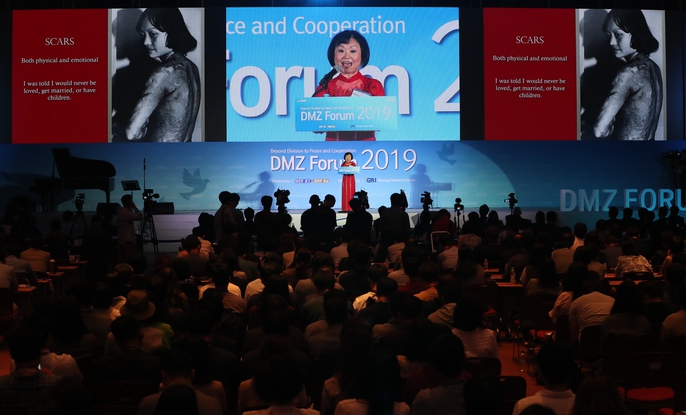 |
|
Phan Thi Kim Phuc, a UNESCO goodwill ambassador for peace and culture, gives a keynote address during the DMZ Forum 2019 in Goyang, Gyeonggi Province, on Sept. 19. (Kim Jung-hyo, staff photographer)
|
Experts discuss origins of inter-Korean border and what should be done with it in future
“The inter-Korean and North Korea-US summits were a symbolic demonstration of the potential of transforming a boundary over which travel had been impossible since the conclusion of the armistice halting the Korean War in 1953,” said Scott Snyder, a senior analyst with the Council on Foreign Relations during the DMZ Forum 2019 on Sept. 19. Snyder was participating in a discussion about the origins of the DMZ and what should be done with it. Following the military agreement that the South and North Korean leaders reached to better implement their Panmunjom Declaration, Snyder suggested, they should return the administration of the border area to civilian control and implement advanced technology there, such as the electronic and video equipment used to monitor an agreement between US and Russia about nuclear arms reduction. Snyder explained that those steps could help transform the demilitarized zone (DMZ) from a bastion of the Cold War into a normal peaceful national border. But Snyder also acknowledged that South and North Korean measures to implement the Panmunjom agreement could be reversed at any time. “It’s important to find measures that are mutually beneficial, rather than merely symbolic. South and North Korea need to look into talks to verify each other’s arms reduction, consisting of concrete steps such as drawing back the number of troops on active duty and removing troops and equipment from the area around the DMZ,” he said. Snyder also raised doubts about whether the détente could be maintained without the complete denuclearization that US President Donald Trump is seeking, as well as uncertainty about North Korea’s internal politics and the limitations of cooperation between the US and China on North Korea because of their ongoing trade war. “There was unprecedented progress last year, but it’s uncertain whether there will be more progress in the future,” he said. On Thursday afternoon, Kim Han-jeong and Park Jie-won, both lawmakers in South Korea’s National Assembly, Former Unification Minister Lee Jong-seok, and Gyeonggi Province Education Superintendent Lee Jae-jeong participated in a discussion about the first anniversary of the inter-Korean Pyongyang Joint Declaration and the era of inter-Korean peace and cooperation. In addition, some 60 domestic and foreign experts participated in 11 sessions on such topics as international cooperation on wildlife diversify in the DMZ and the peaceful utilization of the DMZ through tourism there and in North Korea. One session scheduled for Sept. 20 will cover the topic of prospects and challenges for the denuclearization of the Korean Peninsula, while another will tackle peace on the Korea Peninsula and multilateral collaboration in East Asia, with the discussants including Moon Chung-in, the special presidential advisor for unification, foreign affairs, and national security, and Stanford University professor Siegfried Hecker. By Hong Yong-duk, South Gyeonggi correspondent Please direct comments or questions to [english@hani.co.kr]






